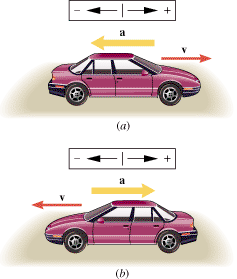A car is traveling along a straight road and is decelerating. Does the car’s acceleration a necessarily have a negative value?
Reasoning and Solution We begin with the meaning of the term “decelerating,” which has nothing to do with whether the acceleration a is positive or negative. The term means only that the acceleration vector points opposite to the velocity vector and indicates that the moving object is slowing down. When a moving object slows down, its instantaneous speed (the magnitude of the instantaneous velocity) decreases. One possibility is that the velocity vector of the car points to the right, in the positive direction, as Figure 2.13a shows. The term “decelerating” implies that the acceleration vector points opposite, or to the left, which is the negative direction. Here, the value of the acceleration a would indeed be negative. However, there is another possibility. The car could be traveling to the left, as in Figure 2.13b. Now, since the velocity vector points to the left, the acceleration vector would point opposite or to the right, according to the meaning of the term “decelerating.” But right is the positive direction, so the acceleration a would have a positive value in Figure 2.13b. We see, then, that a decelerating object does not necessarily have a negative acceleration.
 |
|
Related Homework: Problems 20, 38